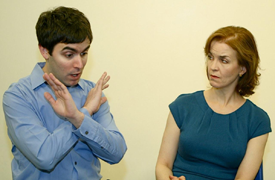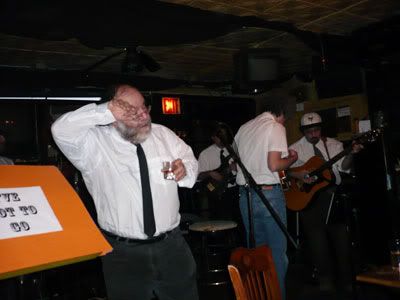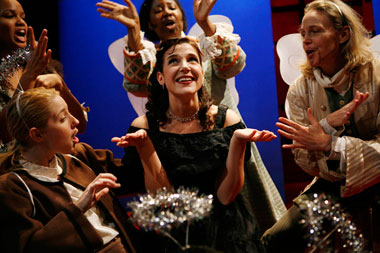Here’s Kevin So playing “Brighter Day” at Spike Hill in Williamsburg on Jan. 31, with me on bass and Robin Lai on drums. Video courtesty of Sitcom Serf.
Author: site admin
Theater Review: The Wendigo
I went to see the Vagabond Theatre Ensemble's The Wendigo with some trepidation. How would Algernon Blackwood's classic horror tale of the Canadian woods translate to the stage? Like his predecessor Poe, Blackwood wrote meticulous and fairly dense prose, and the tale for which he is best known earns its frightfulness through the vividly descriptive power of his language. Too, as with "The Wendigo"'s direct modern descendant, The Blair Witch Project, not much actually happens in it.
Two Brits and two local guides head into the deep woods to hunt moose. One of the guides, Defago, believes too deeply in the Wendigo, a mythical Algonquin figure of terror. When it calls his name, he goes off with it and undergoes an awful transformation.
The story's power lies in its evocation of mysterious primeval forces that may yet lurk in the depths of the forest in spite of human civilization. Such tales electrify our fur by pricking at our most primitive, arboreal fear: that of becoming prey. Dr. Cathcart (Eric Gratton) represents the psychological approach, insisting that the strange goings-on are the result of mental instability brought on by the wilderness. "The Wendigo is simply the Call of the Wild personified, which some natures hear to their own destruction." But finally the psychologist's science can't completely explain what's happened.
Blair Witch took a modern approach to this kind of story, made possible by the medium of film: it placed the audience behind the eyes of the characters. One can't do that in the theater, of course. But one might imagine staging a wordy story like "The Wendigo" by turning it inside out, snaking deep into the minds of the characters in some other way. Playwright Eric Sanders has chosen to tell the story straight, though. Essentially true to the action of the original, his 45-minute version relies heavily, as did the original story, on atmosphere. Here it's created by the trusty trappings of B-movie horrordom: insistent sound effects, spooky music, sudden and extreme lighting changes, a murky forest set – along with that modern theatrical staple, projection.
An able, creative crew handles all these elements with gusto. But in playing it straight Sanders also depends on a lot of narration. Early on, director Matthew Hancock has the young seminarian Simpson (Nick Merritt) storming about the stage as he describes action that we're not seeing. There's nothing wrong with a little narration – that's partly what a Greek chorus was for, after all. But in a play this short, I wished for more showing and less telling.
Maybe that's a lot to ask of a tale in which mood and suggestion are so important, and in which (as in Blair Witch) the "monster" is never really seen. But something was distinctly missing here, and it wasn't from Hancock's direction or from the performances, which were good all around. Of note was Kurt Uy, who plays Defago with a gruff, dark touchiness and a lasered focus. As soon as he appeared, I thought: that man is Defago. And with its direct telling, this production is "The Wendigo." But it's "The Wendigo" minus the rich texture of Blackwood's prose, and the special effects don't fully make up for that.
The Vagabond Theatre Ensemble's production of The Wendigo runs through Feb. 28 at the Medicine Show Theatre, 549 W. 52 St. Tickets at Smarttix or call (212) 868-4444.
Theater Review: Raised in Captivity by Nicky Silver
A parent gets sick or dies; damaged or estranged family members gather. This is the ur-text of present-day American theater. We can't avoid this fundamental plot machine. But we can appreciate what different playwrights do with it.
Dark drama, comedy, absurdity – all are valid approaches. But the talented playwright Nicky Silver tries all three in Raised in Captivity, and perhaps inevitably, though he nails various targets over the course of the longish two-acter, he ultimately gets spun around one too many times and pins the tail on the Led Zeppelin poster.
The play received a Drama Desk Award nomination for Outstanding Play in 1995, and for a good part of the first act I could understand why: it boasts several very funny scenes, then takes an effective if somewhat confusing turn towards darkness as it draws to a close. Emilie Elizabeth Miller is very droll as Bernadette, the motor-mouthed, weight-obsessed sister. Trailing her sad-sack husband Kip (Bryant Mason), a dissatisfied dentist, she reaches out to her prodigal twin brother Sebastian, but he wants no part of her neuroses, or her hospitality.
Josh Lefkowitz, an actor with sparkling comic timing and the not unrelated ability to draw us in to his state of mind with every phrase of spoken or body language, is the best reason to see this production.  His Sebastian is an exquisite sad clown, but he's far from a flat character; the changes he undergoes ring affectingly true right through the end of the play.
His Sebastian is an exquisite sad clown, but he's far from a flat character; the changes he undergoes ring affectingly true right through the end of the play.
José Joaquín Pérez is also excellent in two roles: a convicted murderer whose prison correspondence has become Sebastian's only link to the world outside his own miseries, and a male prostitute who takes a liking to Sebastian. Mr. Pérez is a startling, dangerous sort of presence, like a young, more athletic Dustin Hoffman. His hard-edged, damaged characters pull the play towards a level of sinewy, sweaty reality.
Yet this strand is pulled loose by (among other things) Sebastian's shrink, a character who seems to belong in a different play, a shock-romp of some kind. As the fulcrum of the play's absurdist arm, Jennifer Dorr White does all she can with the strange role, but it's so out there that there's ultimately no there there. An excellent actress, she's more convincing and centered in her secondary role, that of the twins' deceased mother, who pays a post-funerary visit to Sebastian with an honestly shocking revelation.
Mr. Mason plays Kip very broadly, doing, similarly, all he can with a role that quickly becomes a one-note song. Both he and Ms. Dorr find themselves yelling a lot, induced by the script to develop their characters by force of will, rather than by organic growth as with Sebastian. Kip is a quintessential type, a character who abandons his unhappy rut and follows his dream, and we go happily with him for a while. But as he proves quite blind to any subtleties or consequences, the light of humor goes out and he loses us. His deliciously addled wife, meanwhile, gets inexplicably calm and rational in Act Two. That's frustrating because one really wants to feel for the sister as deeply as one does for the brother, but the arcs of the characters don't allow it.
With a beginning that makes us laugh a lot, and an ending that's touching and effective, Raised in Captivity does hold the attention. But ultimately it leaves one wondering what exactly one has been attending. There's a good story in here, and the play is ably staged and well acted. But its crafting is too unsettled. Like a cruise in rough water, it doesn't bore, but it leaves one queasily dissatisfied.
Raised in Captivity runs through Feb. 15 at the the Shell Theater, 300 W. 43 St., NYC. Staged by the Red Fern Theatre Company.
Photo of Josh Lefkowitz and Jennifer Dorr White by Nathan Johnson.
Winter in New York
It Really Is a New Day Dawning… You Know How I Know?
Got a LoJack warning tonight: “Your vehicle may have been moved without your authorization.” Rushed out through the freezing cold to check on the car: gone. Street lined with TV-shoot signs: No Parking Wednesday. Usually they put these signs up a couple of days in advance, but I guess not this time.
But right there was my friendly neighborhood NYC tow truck driver, busy hooking up another vehicle, so I talked to him. Turns out that when you’re towed because of a movie shoot they don’t take you to the pound and make your life miserable and charge you a lot of money. Instead, they tow you around the neighborhood until they find another spot for you, park you, and put a sticker on your car exempting it from being towed or ticketed for 48 hours. When – hopefully within 48 hours – you discover your car is gone and call the cops or the pound, they tell you where it is. Mine had been moved just to the next street over. I checked and there it was, not only safe and sound but in a perfectly legal spot.
I choose to attribute this surprisingly not-so-awful circumstance to the ascension of Barack Obama.
Theater Review (NYC): Terre Haute by Edmund White
In 1995 Timothy McVeigh killed 168 people and injured over 500 more with a truck bomb in the deadliest act of homegrown terrorism ever committed in the United States. A veteran of the first Gulf War, McVeigh had been a survivalist, a "gun nut," and a conspiracy theory believer, but had no previous criminal record. Yet, outraged by what he considered to be tyrannical acts by the US Government, notably the killing of members of the Branch Davidian cult in Waco, TX two years earlier, McVeigh, assisted by just one co-conspirator, took revenge by blowing up a federal office building in Oklahoma City, killing, among many others, a number of children from an onsite daycare center.
McVeigh never expressed remorse or fully explained his motivations. But he did pique the interest of writer Gore Vidal, who believed McVeigh should be taken seriously and not dismissed as a crackpot. Impressed by Vidal's articles about him, McVeigh wrote to the writer, and a correspondence ensued.
The letters haven't been published, and the two never met. But what if they had? What if Vidal had visited and interviewed McVeigh on death row, Truman Capote style? This is the conceit of Edmund White's play Terre Haute, currently receiving its New York premiere at the 59E59 Theaters.
The writer, here named James and loosely based on Vidal and on Mr. White himself, is a Europe-dwelling American septuagenarian who is granted a series of short interviews with the condemned man days before his execution. Playing James is the marvelous Peter Eyre, reprising his London performance. The play would be worth seeing just for Eyre's masterful portrayal of the witty, mordant writer coming rapidly to terms with his own mortality. Simultaneously cool and raw, he walks anxiously about the prisoner's screened-in cage, approaching, backing up, sitting, standing, making literal the journalist's search for an "angle" as he tries to coax the bomber – here named Harrison, and played with explosive rigor by the excellent Nick Westrate – to come clean about how the bombing really went down.
It's a rather fanciful presentation, really. In just 80 tense and occasionally funny minutes the two men, one in a drab gray business suit and the other in an orange prison jumpsuit, go through a week's worth of gamesmanship and emotional openings and closings. Some of the dialogue, especially some of the lines given to Harrison, feel contrived and out-of-character, bookish. Nevertheless, a gripping story emerges. If Harrison is a little unbelievable, James, both horrified and turned on by the bomber, worms his clever, hyper-literate, slightly pathetic way into our hearts wisecrack by wisecrack.
As the two characters clash, revealing themselves in all their hurt, some fundamental similarities assert themselves, unexpected alignments between the stooped, fey, oversexed literary gadfly and the ramrod-backed, under-educated, virginal military man. Harrison had been pushed over the edge when his demons of injustice became too personal. Now he helps push James over an edge as well – though James, unlike the terrorist, will live to bear witness to his own fall.
The dark-Americana musical score by Heather Fenoughty heightens the play's "weird America" atmosphere at critical moments. But White's script is sharp and brainy, and one must approach the play with the patience to focus on just two people in just one featureless space. (The set consists merely of Harrison's cage, a few chairs, and some strewn paper.) Through his creations, inspired by real people but informed by a lifetime of intense observation of the human species, White succeeds in pulling the intellectual and emotional threads together. His tale of two men with hearts as big (for better or worse) as cities ultimately stirs the soul.
Terre Haute continues through Feb. 13 at the 59E59 Theaters, 59 E. 59 St., Manhattan.
Theater Review (NYC): Die Roten Punkte: Super Musikant
The UNDER St. Marks theater is only a little bit off the beaten track, but it's been home to many an off-the-wall production. For three nights only (closing Saturday Jan. 10), it has hosted another. Tonight is your last chance for a while to catch Die Roten Punkte: Super Musikant – unless you live in Canada – and it’s well worth your $18.
This jolly evening of clever musical buffoonery comes courtesy of "Otto and Astrid Rot," a "brother and sister" from a fantastical land called "Germany." With a backstory suggesting a Teutonic version of the White Stripes, Die Roten Punkte ("The Red Dots") mug and squirm through a set of smart and catchy takeoffs on what they insistently call "rock and roll." Really, though, the music – played on child-size guitars (Otto) and drums (Astrid) – ranges from New Wave and Kraftwerk-era robot music to glam-punk and a drinking song, and more. Meanwhile the siblings' tension-filled banter pokes fun at recovery-movement psychology – an easy target, but a big fat funny one as well.
Perhaps the cleverest song is the duo's lengthy origin story. It's a Nick Cave-style dark fairy tale in which the kids' parents are killed in a tragico-absurd manner. Orphaned, the pair dream of being in the "best band in the world." Now, in their own demented universe, they are. The most impressive number, though, is the Kraftwerk sendup about a "robot with feelings," complete with hilarious 80s music video choreography.
The songs themselves are darn good, and the show is equal parts smart and smartass. At the performance I attended, the duo, being total pros, dealt firmly and funnily, but not meanly, with a smart-alecky kid in the audience who was intent on spoiling one of the main jokes. Also, just as the show was getting started, a woman in the audience shouted a hello to "Astrid" using the actress's real name. Man, people are stupid.
Go, be stupid with the Best Band in the World. Visit their website for information on where they're appearing next.
Book Review: People of the Book by Geraldine Brooks
In the hands of a great craftsperson, a humble volume of story and prayer may be re-conceived as a priceless illuminated masterpiece. Witness the Sarajevo Haggadah, a centuries-old volume now counted as one of the most valuable books in the world.
Similarly, in the hands of a fine writer, a slim set of facts about an unusual object can become a powerful and absorbing historical novel. Witness People of the Book, by Geraldine Brooks, the Pulitzer Prize-winning author of March.
The dramatic history of the Sarajevo Haggadah rivals the beauty of its illuminations. Produced in Spain in the 14th century by an unknown artisan, the Haggadah somehow survived the book-burnings of the Inquisition, and was eventually spirited to the thriving Jewish community of Venice. From there, it found its way to Vienna, where, in the 19th century, it was rebound.
Eventually it came to rest to Sarajevo, where (thanks to a brave librarian) it survived Nazi pillaging and now holds pride of place as one of the Bosnian capital's great treasures. But although careful study has revealed much about the Haggadah's provenance, it continues to hold many secrets. From these facts and these secrets, Brooks has woven a fascinating, richly imagined fiction.
Her new novel, People of the Book, works backwards in history. To carry the Haggadah through the centuries, she creates a series of plausibly imagined heroes and scenarios, starting with the horrors of the Holocaust and reaching, finally, all the way back to a beautifully imagined tale of the book's creation.
Framing and setting up the historical sections of the novel is the story of a modern-day book conservator who is pursuing a series of clues, each from a different episode in the Haggadah's odyssey. Hanna Heath's life is something of a soap opera itself. Her adventures in scholarship lead her to international intrigue, romance, and even a secret-princess revelation worthy of a fairy tale.
As Hanna turns into a modest and reluctant action hero, the book as a whole begins to resemble a cross between James Michener's The Source and an Indiana Jones adventure. And I mean both of those in the best possible way.
Hanna's globe-trotting pursuit of the Haggadah's secrets works well as a framing device, but it is in the historical sections that Brooks' storytelling ripens from merely good to transcendent. Each section evokes a colorful, thoroughly believable, emotionally convincing world peopled by complex human beings bathed in vices, diseases, and emotions – all in the space of a short story.
Brooks' writing transports us into these worlds almost as completely as her invented 15th century scribe, David Ben Shoushan, is transported by the marvelous pictures he is incorporating into the Haggadah.
It was in the still of the early hours, when the stars blazed in the black sky, that it happened. His fasting, the chill, the brilliant flare of the lamp: suddenly the letters lifted and swirled into a glorious wheel. His hand flew across the parchment. Every letter was afire. Each character raised itself and danced spinning in the void. And then the letters merged into one great fire, out of which emerged just four, blazing with the glory of the Almighty's holy name. The power and the sweetness of it were too much for Ben Shoushan, and he fainted.
Hanna's own revelations, the personal and the professional, aren't as mystical as that. But she's good company, as Brooks spirits us through the ages on this most excellent adventure.
Music Review: Indie Round-Up – D’Haene, June Moris, Back Door Slam
D'Haene, Vinyl
D'Haene's new disc is spring-loaded with hard-locked rhythms, chunky guitar riffing, and metalized melodies sung with a bluesy, soulful inflection. If, vocally, D'Haene tends to be a touch more convincing on more easy-going fare ("Took Me So Long"), that's because of the soulful quality that defines his vocal style.
One of the CD's best points is the way many of the songs surprise you with unexpected bridges and codas, as in "Wouldn't You Like To Know," or with varied flavors like the Latin opening of "Brand New Threads!" The impeccable musicianship and harmony vocals are also a pleasure throughout. The soul influence becomes explicit with the nodding triplets and organ bed of "I'll Be Your Man," though D'Haene's characteristic guitar buzz remains, maintaining consistency with the disk's overall feel. The same thing happens in the jazzy underpinning of "Playin' It Cool," complete with muted trumpet.
Bookended by the hard-rocking "Another Like You" and "My Woman," this set of solid songs and ace playing is worthy listen.
June Moris, White Spot
June Moris' seven-song disc is a hypnotic set; her quavery voice sounds as if it's bubbling up from an underground stream, accompanied by the hum of insects and distant bells ringing. The atmosphere ranges from a strained, thinly angry pounding, slightly reminiscent of PJ Harvey, to a techno coolness, to a thick Brian Eno drone, but Moris' fluty voice carries through all.
It's an effective, even thrilling tactic through the first five songs. On the sixth track, "The Memory," Moris tries for melodramatic balladry, leaving what seems her natural, postmodern sonic habitat, and it doesn't work as well.
At the end one is left, not with melodies to hang a memory on – Moris isn't about that – but with a pleasingly disturbing sense of disquiet. Shivery mission accomplished.
Back Door Slam, Roll Away and Special EP
The blues-rock power trio is dead?… Long live the blues-rock power trio! Back Door Slam is the real thing. The group, which hails from the Isle of Man, may be barely legal in age, but singer-guitarist Davy Knowles has the grown-up, gritty sound, both vocally and on guitar, demanded by the tradition of Clapton, Gov't Mule, and Robert Cray.
A few tasteful acoustic numbers break up the heavy feel of Roll Away, their debut CD. "Too Late" is a pretty power ballad, but even here Knowles's guitar craftsmanship rides front and center. Ably backed up by bassist Adam Jones and drummer Ross Doyle, and fueled by a deep absorption of the electric blues, Knowles' assured riffs and solos would carry the songs even if the writing weren't inherently good. But in a genre where spectacular playing is sometimes allowed to substitute for songcraft, Back Door Slam's songs stand up well – especially for such a young group.
In addition to Roll Away, a full-length CD of mostly original songs, they've recently released a download-only EP of covers on which they display their more straight-up blues chops. Knowles wails and shreds with brash confidence on a ten-minute live version of "Red House," while the band shows how tight and sharp it can be on John Hiatt's "Riding With the King," the Doors' "Been Down So Long," and a few more.
If there's still a place in the world for guitar heroes and for power trios with a timeless crunch, put Davy Knowles and Back Door Slam on the up-and-coming short list. In a world of hyper-talented young musicians, this is truly impressive stuff, because it feels real.
Freddy’s Still Rules
One of the negatives of moving from Brooklyn to Manhattan is the serious reduction in opportunities to hang out at Freddy’s, the best bar in the known universe. That was remedied the other night courtesy of my gig with the Kings County Blues Band at which an awesome time was had by all. Starting the musical festivities were The Walkers, pictured below, with a set of story songs that were also performance art pieces, with titles like “The Mayor’s Boyfriend” and “The Devil is a Man.” This is the kind of group you have to experience; simple hearing would not do the trick. It was only their second gig ever. Hope they have more.

Now here’s us – well, two of us anyway, Laura Stein and myself – with the KCBB. Below the photo is an MP3 from the show, of me singing Johnny Taylor’s “Last Two Dollars.” I can’t do it like JT, of course, or like my old bandmate Michael Brewster from whom I learned the song, but I think it’s not too bad for a Jewish kid from Long Island. Anyway, let no one say The Bagel and the Rat is not a hip, multimedia blog.

Oh, and of course: long live Freddy’s, and down with Bruce Ratner and Atlantic Yards.
First photo by me, second photo by Elisa Peimer.
Theater Review (NYC): The Klezmer Nutcracker
The Klezmer Nutcracker is an amusing play for children that mixes chanukah traditions and Jewish music with klezmerized themes from Tchaikovsky's Nutcracker Suite. The story, by Ellen Kushner (host of Public Radio's "Sound and Spirit" program) and based on her children's book The Golden Dreydl, won't win any awards for originality, but its winning characters and enthusiastic cast held the kids' attention at the performance I saw.
Bored young Sara (the spunky Danielle Strauss), down with a case of pubescent existential angst, is given, not an enchanted nutcracker, but a magical Golden Dreydl that becomes the Dreydl Princess (the graceful Melana L. Lloyd). This ballerina-like waif takes Sara to a magical kingdom ruled by her parents, Solomon and Sheba – not the biblical or historical characters, but a benevolent sort of Father and Mother Time who oversee a fairyland of Fools, talking animals, and demons who are more funny than scary.
When the demons snatch the Princess, the Tree of Life is threatened, and with it all of Creation… or something. The plot flops around a bit, with story points merely stated, and references and themes flying by at breakneck speed – rather like the Fool, who guides Sara through the enchanted land attempting to rescue the Princess. Dan J. Gordon plays the Fool with a big, loose-jointed nod to Ray Bolger's Scarecrow, and indeed kids may notice strong parallels to The Wizard of Oz, perhaps even more than to the original Nutcracker ballet.
This isn't a ballet, and parents of budding ballerinas should probably mention that fact ahead of time so kids' expectations aren't set unfairly. Nor is it a musical – it's a play with music. Chanukah songs are sung, and there's some boisterous choreography by Dax Valdes, set to recorded music that uses Tchaikovsky's themes transmogrified very cleverly by David Harris and Michael McLaughlin for the fabulous Shirim Klezmer Orchestra.
Most inventive of all is a wonderful Peacock scene, where the talking, preening bird is played by one actress (the amusingly brash Lindsey Levine) while a group of actor-dancers plays her feathers, all making one organism. This sort of thing is the true magic of the theater, the reason to take kids out to a show rather than plop them in front of a DVD.
The Klezmer Nutcracker runs Saturdays and Sundays at 11 AM and 1 PM through Jan. 3, 2009 at the Vital Theatr, 2162 Broadway (at 76th St.), 4th Floor, New York. Call 212-579-0528.
Opera Review (NYC): Henry Purcell’s Dido and Aeneas by The Dido Project at the Samsung Experience
Henry Purcell's 1689 Dido and Aeneas was one of the earliest English operas and is considered one of the composer's masterworks. It runs only an hour but is a true opera. Though the story, taken from Virgil's Aeneid, is a tragedy, Thursday night's performance at the Samsung Experience in the Time Warner Center was a joy, and one of an unusual sort.
The Dido Project comprises a group of singers and the Sybarite Chamber Players under the sparkling direction of Pat Diamond. They've transposed Purcell's Baroque opera about the Queen of Carthage and the hero Aeneas, with its libretto by the Irish poet and playwright Nahum Tate, to the modern boardroom. This Dido is the CEO of a major corporation, while Aeneas, rather than literally shipwrecked on the shores of Carthage, is a tycoon on the verge of economic collapse and in need of a business partner to merge with.
A bit surprisingly, the tale lends itself quite well to the updated setting. One reason is the story's resonance with the modern-day capitalist themes of independence and overwork, particularly for women. This opera is, and always has been, all about women. Indeed, its only major male role is Aeneas himself.
Another factor was the physical setting and the use of technology (I use the past tense because this was a one-time performance, though the group has plans for further events). Many modern theatrical productions use video to enhance or comment on the live action, but usually the screens or projections are fitted after the fact into a space designed mainly for live performance. The Samsung Experience at the Time Warner Center, on the other hand, is a showroom for the company's technology, particularly its screens and other video kit – a "10,000-square-foot interactive emporium of virtual reality experiences and technology."
You are surrounded by video. You walk through video to get to the performance space. You pass computers with interactive displays. Bright lighting and shiny equipment give a science-fictiony sheen to the whole environment. Everything is by Samsung, of course, including the two large screens that framed the stage displaying CNN-like "news" and commentary on the story we were witnessing. The backdrop too consisted of a large multi-panel screen, showing an image of the globe, slowly changing color like a Christmas display, reinforcing the sense that we're in a universe of nonstop worldwide news and action.
The video commentary, complete with a news crawl, was clever and funny and helped to both carry and clarify the story (I liked the novel use of the Windows "blue screen of death"). Its only disadvantage was that it replaced what in some opera performances would have been a display of supertitles. Even in an English-language opera like this one, the words can at times be hard to understand, given the strong vibrato of the female voices and the sometimes unexpected (to modern ears) phrasing of a 17th century libretto.
Still, though the audience may have missed some lines, the singers, with their top-notch voices and fine acting, made the essentials quite clear. And it is a story of essentials.
Dido loves Aeneas, but is reluctant to declare it until her sister (here an executive assistant) Belinda prods her. But three witches who hate Dido and want to ruin her life trick Aeneas into leaving town to fulfill his destiny of founding Rome (here, he is starting a new business venture without Dido). He changes his mind, but too late – Dido's heart has been irreparably broken and, more to the point, her pride fatally wounded: "To your promis'd empire fly/And let forsaken Dido die."
Blythe Gaissert conveyed Dido's sadness ("Peace and I are strangers grown") and precipitous fall with solemn, queenly magnetism. Her voice is strong, supple, almost buttery, and in the famous death scene, which was effectively video-assisted, she was moving and a little funny at the same time. Elena O'Connor as Belinda seemed slightly tentative of voice at first but quickly claimed the full measure of the role, singing beautifully while at the same time clowning divinely.
Alex Loustion was winning as the Second Woman, a more important role than its generic name makes it sound; she did a beautiful job with the lovely aria "Oft she visits this lone mountain." David Adam Moore brought a smooth, strong baritone, impeccable diction, and excellent acting skills to the relatively thankless role of Aeneas (this is a play about women, remember). Sarah Heltzel and Annie Pennies made fine witches, and Jessica Medoff-Bunchman was perfectly spectacular as the Sorceress (the head witch) – if she doesn't have a fan club, someone should start one.
The small Sybarite Chamber Players orchestra played with heart, precision, and even at certain moments a smoky intensity. Purcell's wonderful music lost nothing in the translation of the action to a setting of cutting-edge technology. Along with the musicians themselves, conducted by William Hobbs from the harpsichord, Daryl Bornstein's sound design must get some credit for this.
No more performances of Dido and Aeneas are immediately scheduled; I'm sure they'll be posted at the Dido Project's website when they are. As for the Samsung Experience, you can check it out any time you're in New York – it's right in the upscale mall at Columbus Circle known as the Time Warner Center. A visit to a bright, shiny, holiday-dressed mall in the heart of the greatest city in the world is surprisingly cheering in these tough times. The next live event in the space is an appearance by comedian Mike Birbiglia on Dec. 10 from 4-6 PM.
DVD Review: Composing the Beatles Songbook: Lennon and McCartney 1966-1970
When it comes to Beatles fans, there's a whole spectrum. Some just like the music. At the other extreme are those who obsess over every detail of the band's life and work: reading all the biographies and analyses, studying all the lyrics, following all the legacy news.
This new documentary is for those who fall somewhere in the middle. The information and perspectives imparted by these variously scholarly interviews won't give extreme Beatles geeks anything they don't already know, and to the casual fan they may not be of great interest. For someone like me, though – a serious music listener and Beatles fan, but without the desire (or, I suspect, the brain capacity) for encyclopedic knowledge – it hits the spot.
The documentary focuses on "the centerpiece of their success: the extraordinary songwriting partnership of John Lennon and Paul McCartney." During the years 1966-1970 that partnership took the Beatles from pop stardom to the forefront of musical sophistication and even the avant-garde, resulting in a body of work that continues to stimulate imitation, inspiration, and study decades later. (A previous DVD took up the formative period, from 1957-1965.)
Authors, journalists, and creative souls like Barry Miles, Klaus Voormann, Allan Moore, and Robert Christgau talk about the progression of events and influences that fueled the creativity of the Beatles' two primary songwriters through the period of the group's greatest success. The Dylan influence, Lennon's taking surreal inspiration from random phrases and posters, McCartney's immersion in the London art scene, the challenges of Frank Zappa's experiments and The Who's noise-rock – all these and more collect into a pretty well-rounded picture of what made these boys tick.
George Harrison's songwriting contributions, which became very significant in the later period, aren't covered here, and one misses them – not because the filmmakers don't deliver on what they promise, but because one can't feel fully immersed in the world of Beatles music without Harrison. But purely as a study of the songwriting of Lennon and McCartney, it succeeds. The documentary footage is interesting, if limited, and despite the dry, semi-scholarly tone, one gets fairly caught up in the excitement and emotions of a time when pop music was becoming much more than trifles for the ear.
Since the focus is on a small selection of representative songs, full versions of them would really improve the film. Beatles fans most likely have all the songs anyway, but being able to listen right then and there would certainly be a plus. Of course, getting the full rights to songs can be difficult or impossible, especially for independent filmmakers.
Extras are scant: a structural analysis of the song "A Day in the Life" by Allan Moore (just the sort of thing I find fascinating), and textual biographies of the contributors. The latter are useful because I didn't know who half of these people were, and it's good to see what makes them "experts." British fans will find more of them familiar names.
For the obsessive Beatles fanatic who knows everything but also needs everything, this will be a welcome addition, but non-completists can probably take a pass. For those who are merely highly interested, it's definitely worth a look.
Theater Review (NYC): Zero by Danny and Robert O’Connor
Things are bigger in Texas, and people live life a little slower. Maybe they just need more time to take it all in, since there's so much of it.
Zero, an import from Dallas (it has also played in Chicago), reflects something of that vast Lone Star spirit. For a one-man play, it's bigger than a lot of what we're used to here in frenetic New York City. Parts of it go a shade or two too slow for my caffeinated heart to beat to. The twenty-somethings whom Danny O'Connor brings to life on stage spend their days sloshed in beer, tequila, and Jagermeister instead of coffee and protein shakes.
There's no denying the craft, stamina, and supersized ambition of the play's primary power source. O'Connor, on stage by his Lone Star lonesome for over two hours, plays six different characters, sometimes three at a time, while working through two separate storylines. All of them are precisely eight years out of high school, but he defines them with easy changes in accent, demeanor, and posture, loading each with personality in the process. Yet O'Connor sketches in their details just enough to make us want to know more about them; we'd like to see deeper into them than their war stories, their obsession with a high school flame, their drinking to excess.
The occasion for the main storyline is the return of Alex, one of the high school buddies, from the Iraq War. Alex reflects the play's origin: O'Connor and his brother Robert collaborated on the script long-distance during the latter's service in Iraq. Then, after his second tour, Robert committed suicide.
That grim backstory doesn't make the play a downer, though. To the contrary, it's pretty jolly, especially considering its protagonists' inability to achieve satisfaction, the low-level sadness underlining their lives. They are all, in various ways, the "zeros" of the title, although only boisterous Sam, the group's "good ole boy," refers to himself that way. "High school's with us forever, dude," he tells his actor pal Len, who has quit trying to make a career of what he loves.
Sam, despite being something of a caricature, is the best fleshed out of the three drinking buddies. Eternally trapped in sarcasm, he waxes philosophical: "Some people just aren't meant to follow their dreams." Yet in context, his bittersweet bluster is more humorous than sad, and that's a good thing, because the play's funny lines and body language and the intermittent outrageousness are what keep things moving as well as they do.
It's in the scenes where Sam, Len, and Alex get together that the action slows. O'Connor plays all three parts nimbly, but a lack of crispness in the dialogue bogs us down. By contrast, he transports us in high style when he's "by himself" – in the wordless opening, when Len wakes up from a humongous hangover and tries sourly to get the day going with a lot of help from a bottle of water and a toilet; in the monologues from James and Gabe, a preening metrosexual and a sad sack, whose planned night out constitutes the secondary storyline; in the hysterically pretentious performance piece by "Malthazar," who cracks us up even as we realize that his kind is a pretty easy target.
Zero is an impressive performance, and an enjoyable evening out, but one that would be more enjoyable if it were trimmed or tightened. Look out for Danny O'Connor; this fine, Texas-sized actor and monologist is a darn sight more than the sum of his "zero" parts.
At the Roy Arias Theatre 2, 616 Ninth Ave. at 44th St., NYC, through Dec. 30. For tickets please visit Theatermania or call 866-811-4111. For more information visit the Zero website.
Music Review: East Village Opera Company – Olde School
The operatic tradition has always had a place in rock and pop. Elvis Presley and the Platters' Tony Williams, Pat Benatar and Heart's Ann Wilson, metal's Ozzy Osbourne and pop-rock's Dennis De Young, and of course Freddie Mercury, are all singers who have adopted, at certain times and to one degree or another, opera's highly controlled vocal techniques rooted deep in the body.
At the same time, bands and arrangers have utilized orchestras, mellotrons, samplers, synthesizers, and dense, powerful vocal layerings to capture in popular music the bombastic drama of composers like Wagner and Verdi. Just think of the Beatles' late, highly orchestrated experiments, Queen's "Bohemian Rhapsody," The Who's "Mini-Opera" and Tommy, Black Sabbath's "War Pigs," and almost anything from Led Zeppelin's peak period.
The East Village Opera Company comes from the other direction, taking famous themes and arias from classic operas and crafting variously flavored pop music around them. Their adaptations, while often clever, are not mere exercises, but really enjoyable music in their own right.
Producer-arranger Peter Kiesewalter and the group have a fine knack for finding modern-day settings for timeless themes without the self-conscious slickness you sometimes find in pop-classical crossover projects. The opening track, a pastiche of Wagner, Led Zeppelin, and Rush, is something of an exception. But overall the music has a fairly consistent sensibility. One gets the sense that the East Village Opera Company is a band, no less than The Beatles or Black Sabbath were.
Granted, this band has a bevy of guest artists in addition to its core of three singers and excellent musicians (they carry three string players when on the road): a pedal steel player on "As You Were Then" adapted from Bellini's Norma, soprano star Nicole Cabell on "Brindisi Libera (Pop the Cork)" from Verdi's La Traviata, a very effective children's chorus on "Soldiers" from Gounod's Faust, and more. There are touches of jazz, funk, and even country, and a bit of schmaltz of the sort you get from operatic pop singers like Josh Groban and Sarah Brightman.
But the singers don't sing like opera singers, most of the time, nor like opera singers trying to sing pop music, but simply like very good pop singers. And some of the opera themes are pretty well disguised. My sense is that a pop music fan completely ignorant of opera would likely enjoy this disc, although less so than someone familiar with opera. As such it's not the kind of thing that would tend to draw a potential fan into the world of opera.
But I don't get the feeling that's what the group is aiming for. I think they're aiming, like any band, to earn fans, to do something different or exceptional, to put on a good show, and maybe sell some recorded music in the process. I for one am looking forward to the next opportunity to see them live.
Theater Review (NYC): Twelfth Night by William Shakespeare, Presented by the Queen’s Company
The all-female Queen's Company updates the classics with a modern pop-culture sensibility, while remaining true to the language, the story, and the groove of the original text. With a comedy like Shakespeare's Twelfth Night, this gang is also funny as hell. In fact, I laughed so much I got a headache. Damn you, Queen's Company.
One might imagine that Twelfth Night, with its cross-dressing plot and high ribaldry, would be perfect – or else problematic – for an all-female troupe. In fact, it is neither. The cast is overall so skilled, and directed so cleverly by Rebecca Patterson, that we hardly sense the non-traditional casting at all. The production succeeds entirely on the same merits as would any good Shakespearean staging, whether cast with men and women, with all men as in Shakespeare's time, or with the women of the QC.
It's been three years since I last saw one of this group's productions. Since that time they've maintained their energy while building their skills even further. Patterson's staging conceptions are brisk as ever, but have deepened, with increased subtlety. The cuts are judicious. The actors' line reading choices serve both clarity and high spirits. And the musical numbers just have to be seen to be believed.

It's a good thing she has excellent castmates to play off of, otherwise Aysan Çelik might steal the whole show. Her dart-sharp, hilarious Malvolio preens and pouts and struts, carrying us along with every move or glance. She even pulls her weight when she's not on the stage, merely being talked about. Carey Urban, who played Kate with panache in the company's Taming of the Shrew, makes a flouncy and tangy Olivia, and Virginia Baeta is a delightful, gamine-like Viola. Only Gisele Richardson's Sir Toby Belch could be improved – though it's a physically spot-on performance (and she's done up like a riotously drunken Al Sharpton), the lines are sometimes lost in swallowed diction.
Feeling drowned in our gloomy economic times? Get shipwrecked with Viola and her brother Sebastian (the elfin Amy Driesler) in the court of Duke Orsino (the regal Frances Uku) and his fool, Feste (the sly Natalie Lebert). A dip into The Queen's Company's singing, dancing, and fully Shakespearean version of fanciful Illyria is just the tonic for troubled days like these.
Twelfth Night plays through Nov. 23 at Urban Stages, 259 W. 30 St., NYC. For tickets visit Smarttix or call 212-868-4444. For more information visit the Queen's Company online.
Photo (L-R): Carey Urban as Olivia (center) and the angels (beginning at lower left & going clockwise) Valerie Redd, Kari Nicole Washington, Gisele Richardson and Karen Berthel. Photo credit: John Santerre
Book Review: Wandering Star by J. M. G. Le Clézio
What to do with the weight of expectations? The French novelist J. M. G. Le Clézio is not well known in the English-speaking world, and many of us might never have heard of him had he not been awarded the 2008 Nobel Prize in Literature. Now we have had the pleasure of that introduction, but because of the prize, we also feel the burden of expecting greatness.
Greatness probably can't be ascribed to any author based on the reading of one fairly short book. Nonetheless, Le Clézio's 2004 novel Wandering Star is unquestionably a work of power and beauty even in this suboptimal translation.
It tells the story of Esther/Hélène, a girl from a secular Jewish family forced by the Nazi invasion to flee their home in Nice. In the countryside, in a small village, under the dubious protection of the less-murderous Italian military, she comes of age.
Eventually Esther reaches Israel, where she encounters Nejma, a Palestinian refugee her own age. We read Nejma's story in a separate section, but the contrast between the trajectories of the two lives is clear, and crushing.
Having borne many trials but escaped the full horror of the Final Solution, Esther has arrived at her promised land. Israel's War for Independence is raging, and it seems life for her is an endless whirl of destruction, yet she is a survivor. But in order for the Jewish refugees to establish their homeland, another people – Nejma's – is uprooted and transformed into refugees themselves, persecuted in their turn not by murderous armies bent on genocide – though plenty die in battle – but by starvation and disease. Though the two girls meet but once, their dual stories comprise a singular tale of the nightmare of war, and the promise – and tragedy – of human migrations.
The translation has problems. Not having the original French in front of me, I don't know to what extent the translator, C. Dickson, has adhered to Le Clézio's French sentence constructions. But whether from too-literal rendering, or carelessness, or some other reason, too many sentences must be read twice. The reason is nonstandard punctuation, primarily the use of commas to create run-on sentences, and other careless constructions: "Elizabeth had followed her into the bushes, she caught up with her on the bank of the river, breathless, her legs scratched from the brambles."
The poetry of the writing blasts through nonetheless, even in passages such as the above. It burns down like the desert heat beating down on Nejma as she passes her days in a refugee camp at what feels like the end of the world. In the following passage, Nejma, who has grown up by the sea but now languishes in the dry, dusty camp, has just witnessed a young pregnant woman being bathed, her "long braids twirled around on her back like wet snakes."
Outside the sun was still dazzling. The camp was heavy with dust, with silence. Before nightfall, I was up on top of the hill, my ears filled with the sounds of water and the droning voice of the old woman. Perhaps I had stopped seeing the camp through the same eyes. It was as if everything had changed, as if I had just arrived, as if I were unfamiliar with the stones, the dark houses, the horizon obstructed by the hills, the dried-up valley scattered with scorched trees where the sea never comes.
Through Esther's life story and Nejma's, Le Clézio bathes even the muddy or humdrum moments in muted light like this. Yet the girls' suffering is almost palpable, both Nejma's physical destitution and Esther's literal and psychological displacement. Esther lives on, a survivor; Nejma's fate remains cloudy. But having read their stories, so different and so similar, we are left with one rock-solid truth: there is no simple right or wrong.
And there is a second truth, this one buried in the author's way of telling itself. It's Keats's youthful truth, that beauty is truth and truth beauty. This truth, carried to us on the wings of great art and literature, can survive the worst of times – however unexpectedly.
Music Reviews: Matt Morris, Lee “Scratch” Perry, Asylum Street Spankers
Matt Morris, Backstage at Bonnaroo and Other Acoustic Performances
Listening to Matt Morris, intimate is the word that comes most readily to mind. His high, fluty tenor, recorded closely into the mic, wafts his words into your consciousness like a message carried on the wind.
The first three songs on this sparsely produced EP have little more than Morris's voice and acoustic guitar, with a few subtle lead guitar fills. For the final two tracks he switches to piano. On "Let It Go" Morris flutters close to Antony territory. The disc closes with "The Un-American," a deceptively sweet-sounding condemnation of consumer culture that nicely bookends the opener, "Money," with its pithy explanation that "Money ain't the villain / It's greed that's the killer."
Speaking of money, Morris, known for writing for Christina Aguilera and Kelly Clarkson, is being championed by Justin Timberlake. But in spite of these glittery associations, as a singer-songwriter he has a way of gently delivering serious lyrics that harks back to the early solo work of David Crosby, and to the more modern singer-songwriter feel of Elliott Smith. At the same time, his voice, though soft and plaintive, has an up-close tang and controlled yet emotional falsetto heights that make one think of what Jeff Buckley might have sounded like if he'd been able to write material with real hooks.
Lee "Scratch" Perry, Scratch Came Scratch Saw Scratch Conquered
It's hard to keep up with dub-reggae pioneer Lee "Scratch" Perry, even for us relative youngsters. At 72, he's still putting out a full-length CD roughly every year.
Since I last wrote about Scratch he's released two discs. The newest features appearances by Keith Richards and George Clinton, but despite the heavy-hitting guests, this hourlong CD is all about Scratch and his new collaborator-producer Steve Marshall. (The two also worked together on Scratch's Grammy-nominated disc last year.)
Either you dig Scratch or you don't. Trancelike but jovial, self-obsessed but always with a slightly scary wink, the man and the music seem one. The dub and classic reggae elements are all here: the horns, the repetition, the stops, the sound effects, the social consciousness, the religion, the aphorisms, the weed. Then Scratch adds the flights of fancy and the wordplay. "Riches come / And riches goes / Cigarette come / Cigarette goes / But I remain / I am the rain / I remain," he declares in "Jealousy."
"Sinful Fuckers" needs no further explanation.
"Ha ha ha ha," he proclaims sleepily in "Yee Ha Ha Ha." "La la la la / Ha ha ha ha." And so it goes. Light something up and dive in. But look out. As George Clinton intones, "Headz Gonna Roll."
Asylum Street Spankers, What? And Give Up Show Biz?
The busy Asylum Street Spankers are back with a live double CD recorded at a series of concerts in New York City earlier this year. The Spankers are always fun, but they're more fun in person, and this set captures a good bit of the wacky, childish-for-grownups fun that makes their concerts such a hoot.
There's a mix of favorite Spankers numbers ("Beer," "Winning the War on Drugs," "Blade of Grass"), newer tunes, and classic covers like "I Got My Mojo Workin'" and "Since I Met You Baby," all strung together with spit, twine, musical saw, between-songs banter, and silly tales about life on the road. There are even a couple of songs from the band's recent children's album, including "You Only Love Me For My Lunchbox." And don't miss "Hick Hop," Wammo's fusion of country and western murder ballads and gangsta rap.
The Spankers handle blues, old-timey jazz, country, bluegrass, nearly every style you might hear at a postmodern vaudeville show – even a little rock – with equal skill, and a big dollop of silliness that wouldn't work half as well without the high-level musicianship; they make it look (or sound) easy.
Most often I wouldn't suggest a live album as a good introduction to a band, but if you haven't heard the Spankers, and you don't mind a fair amount of banter in between songs, this wouldn't be a bad place to start at all. At the very least it will probably make you want to catch a show when this clever, funny, and well-traveled band of zany gypsies comes to your town.
Red-Tailed Hawk
Creatures of New York, Pt. 4
The theme of this edition of Creatures of New York is:
The Abandoned.
First, here is an abandoned bear, hung from a fence in Madison Square Park.

Similarly, this poor donkey or horse was abandoned in Cooper Square.

Traffic cones are surprisingly loaded with personality. This poor guy – or girl, it’s hard to tell in its crushed condition – has ironically collapsed into the hole it was put in to warn against.

This Lion Brand Yarn store is about to re-open on 15th St. Gotta love their lion.

Finally, an aftermath shot I like to call, “The Madder Hulk Gets…”




